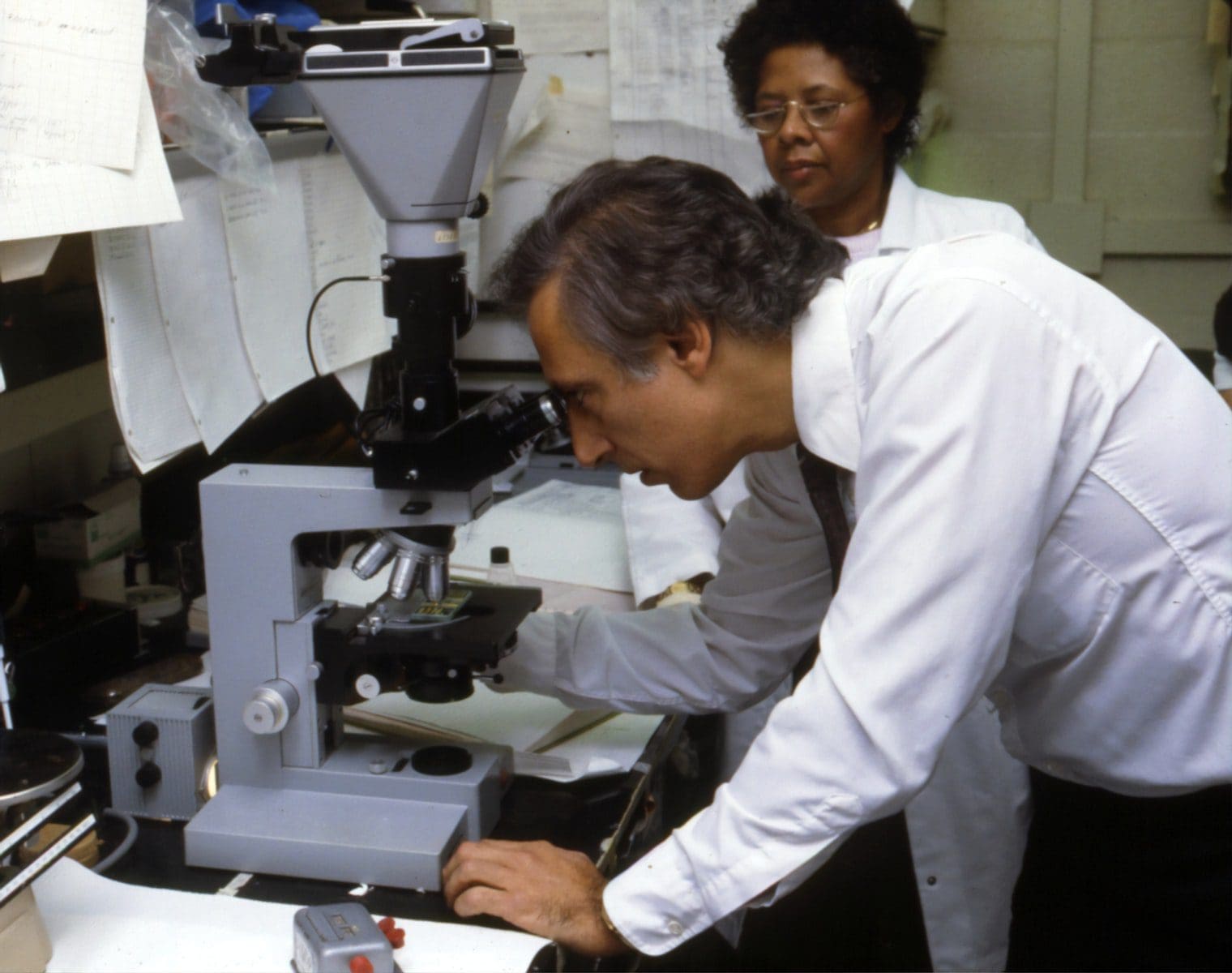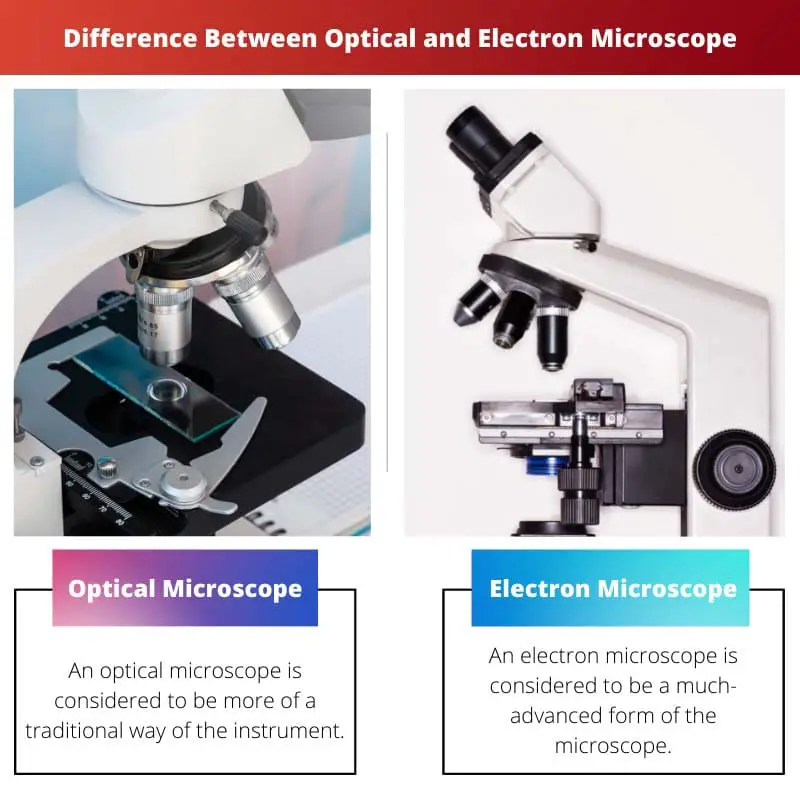A microscope is considered to be an instrument in the field of science that is conventionally used to examine various kinds of specimens. The microscope works as an instrument to provide clarity while examining any objects profoundly.
It focuses on a particular object and tends to produce extremely detailed enlarged pictures of the smallest objects or an organism.
Key Takeaways
- An optical microscope uses visible light to magnify images, while an Electron microscope uses a beam of electrons.
- An optical microscope has a lower magnification and resolution than an Electron microscope, which has a higher magnification and resolution.
- Optical microscopes can observe living cells, while Electron microscopes require cells to be dead or chemically fixed.
Optical Microscope vs Electron Microscope
An optical microscope is a device that uses light beams or photon particles and lenses to magnify the images of small samples. It has a magnification power of 1000 times to examine a detailed image of an object. An electron microscope is a device that uses particles of electrons and lenses to illuminate and magnify the images of samples. It has a magnification power of up to 10,00,000 times to produce a high-clarity image.

An optical microscope is used for more general purposes of examining objects. An optical microscope uses the beams of light or particles of a photon to produce energy which initiates the examining process.
It is more of a traditional way of examining, which made a revolutionary change in the field of science and medicine.
An electron microscope is used for a more specific examination of objects under the effects of electrons as it uses the beams of electrons to inspect how the electron particles interact and react with the particular object under inspection.
It is a more advanced version of a microscope that uses the particles of an electron to proceed to examine.
Comparison Table
| Parameters of Comparison | Optical Microscope | Electron Microscope |
|---|---|---|
| Source | The light source or photon particles. | Particles of electrons. |
| Type of lens | It uses a much simpler type of lens for examining. | It uses an advanced electromagnetic lens for examination. |
| Work efficiency | It produces less detailed images of objects. | It is more advanced and can provide much greater details in the clarity of the image. |
| Affordability | Much cheaper than that of an electron microscope. | More on the expensive side of the price range. |
| Magnification Power | It possesses magnification power of 1000 times to produce an image of the object. | It possesses magnification power that can even extend up to 10,00,000 times to produce an image. |
What is Optical Microscope?
An optical microscope is considered to be more of a traditional way of the instrument, as it uses the source of energy from the particles of a photon in the atmosphere or the light energy which helps to produce an enlarged version of a particular object for the examining process in the field of science.
An optical microscope is the oldest form and is also much simpler to use than that of the advanced microscopes that came out later. It can be very useful as it is easy to operate and can be handled for general purposes.
An optical microscope also has the use of a simple lens that we come across even in our daily life, that is, the concave mirror to examine.
An optical microscope may have lower resolution power in comparison to other technologically advanced microscopes, but it can still be used to inspect objects starting from a wide range which helps and contributes to the research of those objects in studying science.
It provides up to 1000 times of magnifying power while producing an enlarged image of a particular object for research purposes in general use.
An optical microscope is also very cost-efficient and can be installed easily as it is a much simpler instrument that examines objects at an affordable cost than other advanced microscopes.

What is Electron Microscope?
An electron microscope is considered to be a much-advanced form of the microscope when it comes to the research purpose of highly complicated objects or structures that cannot be examined over a simple microscope. It uses an electromagnetic lens for the examination of objects.
An electron microscope uses the particles of electrons to study the effects of the movement of electrons with the desired object. The changes in the way the electrons react when in contact with a particular object help to determine the characteristics of that object.
Highly efficient Electron microscopes can produce images with great details in the structure. It can produce magnifying power of much larger than 1000000 times of clarification while examining an object and can also extend up to the need.
It can also produce colored images of the examined object.
An electron microscope comes to a lot pricier than other simpler microscopes as it is highly advanced in its apparatus. It also takes a few days to prepare the specimen, depending on the examination object.
It cannot be installed just anywhere without having proper knowledge and permission to handle extensive research work.

Main Differences Between Optical and Electron Microscope
- An optical microscope can produce only black and white images, while an electron microscope can produce even colored images to help better understand.
- An optical microscope uses colored dyes to stain the object under examination. In contrast, an electron microscope heavily coats the object with metal before examining it.
- An optical microscope needs about a few hours to prepare the specimen needed to be examined. On the other hand, it takes even up to days to prepare the specimen in an electron microscope.
- An optical microscope can examine both dead and living objects. But, an electron microscope can only examine dead or dry objects under its precision.
- An optical microscope uses a simple lens, while an electron microscope uses an electromagnetic lens for examination.

References
- https://iopscience.iop.org/article/10.1088/0508-3443/6/11/304/meta?casa_token=bS9XiqNYq2kAAAAA:fjqMc5xYU04bmCAEtOadvQ7UzSK0xdDR5amc0gQLOuBXjhG9OQ3lag9m_37FoGnQpX9tHV2Idn-0aQ
- https://europepmc.org/article/med/2740861

I’m impressed by the level of detail in this article. It covers the topic comprehensively and is a valuable resource for anyone studying microscopy.
Absolutely, Ian16. This article is a significant contribution to understanding microscope technology.
The depth of information here is commendable. A well-researched piece.
This article is lacking in depth. While it touches on the basics of microscopy, it fails to delve into advanced concepts in this field.
I disagree. This article provides a clear overview of microscope types and their differences, which is valuable for those new to the topic.
I absolutely love how detailed this article is! It’s so informative and explains the differences between optical and electron microscopes really well.
I agree! This is a great read for anyone interested in science and microscopy.
This comparison between optical and electron microscopes is excellent. It highlights the advantages and use cases of each device very well.
Agreed. This article has effectively outlined the functionalities of these microscopes.
I expected more details about the history and evolution of microscopes in this article. It feels incomplete.
This is a fantastic elucidation of microscopic technology. The comparison between optical and electron microscopes is really enlightening.
I share your sentiment, Aiden56. This article provides an insightful overview of microscopic tools.
I concur. The detailed analysis in this article is impressive.
The information provided here is fascinating. I appreciate the breakdown of the key takeaways and the detailed comparison between optical and electron microscopes.
Absolutely! This article is a fantastic resource for understanding the fundamental differences in microscopes.
The explanation of optical and electron microscopes is quite thorough and well-structured. A commendable piece of literature.
Absolutely, Vwilkinson. This article is a testament to the depth of knowledge about microscopy.
I find the tone of this article a bit dry. It’s informative, but lacks a conversational or engaging touch.
I see your point, but I appreciate the straightforward presentation. Sometimes clarity is more important than a conversational tone.
I agree with Stefan35. A more engaging approach could make this article more compelling for readers.
The comparison table is a great addition to this article. It presents the information in a clear, organized manner.